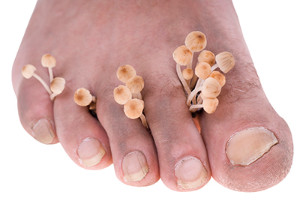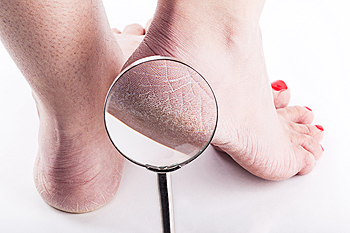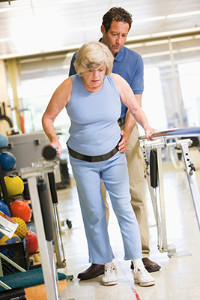July 2018
How Many Different Types of Corns Are There?
 If you have ever experienced a corn on the top of the toes, you most likely are aware of the pain that is associated with it. Corns are generally the result of increased pressure and rubbing, and typically originates from shoes that do not fit correctly. It appears to be a small area, and the skin will be hardened and thick. There are known to be two types of corns and are referred to as hard and soft corns. The latter generally develops in between the toes and are often soft, because of the excess moisture and sweat that is present. Hard corns come from wearing shoes that are too tight and may often cause the toes to endure unwanted pressure, resulting in pain and discomfort. There are different types of treatments that may be used to eliminate corns, and it’s advised to speak with a podiatrist for possible relief options that are correct for you.
If you have ever experienced a corn on the top of the toes, you most likely are aware of the pain that is associated with it. Corns are generally the result of increased pressure and rubbing, and typically originates from shoes that do not fit correctly. It appears to be a small area, and the skin will be hardened and thick. There are known to be two types of corns and are referred to as hard and soft corns. The latter generally develops in between the toes and are often soft, because of the excess moisture and sweat that is present. Hard corns come from wearing shoes that are too tight and may often cause the toes to endure unwanted pressure, resulting in pain and discomfort. There are different types of treatments that may be used to eliminate corns, and it’s advised to speak with a podiatrist for possible relief options that are correct for you.
If you have any concerns regarding your feet and ankles, contact Dr. J. Mari Adad of Pro Sports Club Podiatry. Our doctor will treat your foot and ankle needs.
Corns: What are they? And how do you get rid of them?
Corns can be described as areas of the skin that have thickened to the point of becoming painful or irritating. They are often layers and layers of the skin that have become dry and rough, and are normally smaller than calluses.
Ways to Prevent Corns
There are many ways to get rid of painful corns such as wearing:
- Well-fitting socks
- Comfortable shoes that are not tight around your foot
- Shoes that offer support
Treating Corns
Treatment of corns involves removing the dead skin that has built up in the specific area of the foot. Consult with Our doctor to determine the best treatment option for your case of corns.
If you have any questions please feel free to contact our office located in Bellevue, WA. We offer the newest diagnostic and treatment technologies for all your foot and ankle needs.
Read more about Understanding Corns and CallusesReminder - When was the last time...
Can Toenail Fungus Be Prevented?
 Many people are unaware that they may have toenail fungus, and this may often be a result of a lack of pain and discomfort. Common symptoms that are associated with this ailment may include the toenail becoming dry and brittle, the nail appearing yellow and thick, or a separation from the nail and the nail bed. It’s important to take proper care of your feet, which may possibly avoid this unsightly condition from developing. There are several ways to accomplish this, including wearing shoes that fit properly, trimming the toenails correctly, and wearing appropriate shoes in the shower and pool areas. If you are afflicted with toenail fungus, it’s suggested to speak with a podiatrist who can provide proper guidance for the best treatment options.
Many people are unaware that they may have toenail fungus, and this may often be a result of a lack of pain and discomfort. Common symptoms that are associated with this ailment may include the toenail becoming dry and brittle, the nail appearing yellow and thick, or a separation from the nail and the nail bed. It’s important to take proper care of your feet, which may possibly avoid this unsightly condition from developing. There are several ways to accomplish this, including wearing shoes that fit properly, trimming the toenails correctly, and wearing appropriate shoes in the shower and pool areas. If you are afflicted with toenail fungus, it’s suggested to speak with a podiatrist who can provide proper guidance for the best treatment options.
For more information about treatment, contact Dr. J. Mari Adad of Pro Sports Club Podiatry. Our doctor can provide the care you need to keep you pain-free and on your feet.
Toenail Fungus Treatment
Toenail fungus is a condition that affects many people and can be especially hard to get rid of. Fortunately, there are several methods to go about treating and avoiding it.
Antifungals & Deterrence
Oral antifungal medicine has been shown to be effective in many cases. It is important to consult with a podiatrist to determine the proper regiment for you, or potentially explore other options.
Talcum powder – applying powder on the feet and shoes helps keep the feet free of moisture and sweat.
Sandals or open toed shoes – Wearing these will allow air movement and help keep feet dry. They also expose your feet to light, which fungus cannot tolerate. Socks with moisture wicking material also help as well.
If you have any questions please feel free to contact our office located in Bellevue, WA. We offer the newest diagnostic tools and technology to treat your foot and ankle needs.
Read more about Toenail FungusWhat Causes Cracked Heels?
 If you stand for extended periods of time you may experience a condition that is referred to as cracked heels. Certain skin conditions that may include psoriasis and eczema may also play a significant role in the development of this condition. The formation of deep cracks, which are also known as fissures, may result in pain and discomfort, and walking may become difficult. The skin on the heels will typically become dry and is usually a result of obesity, wearing shoes that have an open back, and cold winter weather, which may aid in producing dry skin. An effective remedy includes washing and drying the feet thoroughly, followed by utilizing a good moisturizer that will help the skin become soft. It’s advised to consult with a podiatrist if you are afflicted with severely cracked heels, to learn about proper treatment options that are correct for you.
If you stand for extended periods of time you may experience a condition that is referred to as cracked heels. Certain skin conditions that may include psoriasis and eczema may also play a significant role in the development of this condition. The formation of deep cracks, which are also known as fissures, may result in pain and discomfort, and walking may become difficult. The skin on the heels will typically become dry and is usually a result of obesity, wearing shoes that have an open back, and cold winter weather, which may aid in producing dry skin. An effective remedy includes washing and drying the feet thoroughly, followed by utilizing a good moisturizer that will help the skin become soft. It’s advised to consult with a podiatrist if you are afflicted with severely cracked heels, to learn about proper treatment options that are correct for you.
If the skin on your feet starts to crack, you may want to see a podiatrist to find treatment. If you have any concerns, contact Dr. J. Mari Adad from Pro Sports Club Podiatry. Our doctor can provide the care you need to keep you pain-free and on your feet.
Cracked Heels
It is important to moisturize your cracked heels in order to prevent pain, bleeding, and infection. The reason cracked heels form is because the skin on the foot is too dry to support the immense pressure placed on them. When the foot expands, the dry skin on the foot begins to split.
Ways to Help Heal Them
- Invest in a good foot cream
- Try Using Petroleum Jelly
- Ease up on Soaps
- Drink Plenty of Water
Ways to Prevent Cracked Heels
- Moisturize After Showering
- Skip a Shower
- Keep Shower Water Lukewarm
- Don’t Scrub Your Feet
If you are unsure how to proceed in treating cracked heels, seek guidance from a podiatrist. Your doctor will help you with any questions or information you may need.
If you have any questions, please feel free to contact our office located in Bellevue, WA. We offer the newest diagnostic and treatment technologies for all your foot care needs.
Read more about Solutions for Cracked HeelsHow Can I Find Relief From My Arthritic Feet?
 If you are afflicted with arthritic feet, you may find it difficult to perform certain activities, including walking. There is typically a moderate level of inflammation that surrounds the joints of the foot, which may produce considerable pain and discomfort. There are several different forms of arthritis which may affect the feet. If the cartilage begins to decay at the base of the toe, you may have what is referred to as osteoarthritis. This may contribute to other foot conditions such as bunions. Preventive measures may include choosing to wear wider shoes that do not put pressure on the bunion. Additionally, if the joints on the ball of the foot become inflamed, you may have rheumatoid arthritis. This may cause the bone to rub and push against the skin on the sole of the foot, which can often produce severe pain. A possible treatment option that may temporarily provide moderate relief involves attaching a long strip of leather to the bottom of the shoe behind the arch. This may aid in reducing a portion of the pressure that is often associated with this type of arthritis. It’s suggested to consult with a podiatrist to discuss further relief remedies and treatment protocols.
If you are afflicted with arthritic feet, you may find it difficult to perform certain activities, including walking. There is typically a moderate level of inflammation that surrounds the joints of the foot, which may produce considerable pain and discomfort. There are several different forms of arthritis which may affect the feet. If the cartilage begins to decay at the base of the toe, you may have what is referred to as osteoarthritis. This may contribute to other foot conditions such as bunions. Preventive measures may include choosing to wear wider shoes that do not put pressure on the bunion. Additionally, if the joints on the ball of the foot become inflamed, you may have rheumatoid arthritis. This may cause the bone to rub and push against the skin on the sole of the foot, which can often produce severe pain. A possible treatment option that may temporarily provide moderate relief involves attaching a long strip of leather to the bottom of the shoe behind the arch. This may aid in reducing a portion of the pressure that is often associated with this type of arthritis. It’s suggested to consult with a podiatrist to discuss further relief remedies and treatment protocols.
Arthritis can be a difficult condition to live with. If you are seeking treatment, contact Dr. J. Mari Adad from Pro Sports Club Podiatry. Our doctor can provide the care you need to keep you pain-free and on your feet.
Arthritic Foot Care
Arthritis is a joint disorder that involves the inflammation of different joints in your body, such as those in your feet. Arthritis is often caused by a degenerative joint disease and causes mild to severe pain in all affected areas. In addition to this, swelling and stiffness in the affected joints can also be a common symptom of arthritis.
In many cases, wearing ill-fitting shoes can worsen the effects and pain of arthritis. Wearing shoes that have a lower heel and extra room can help your feet feel more comfortable. In cases of rheumatoid arthritis, the arch in your foot may become problematic. Buying shoes with proper arch support that contour to your feet can help immensely.
Alleviating Arthritic Pain
- Exercises that stretch the foot can prevent further pain and injury and increase mobility
- Most of the pain can be alleviated with anti-inflammatory drugs, heat, and topical medications
- Massages can help temporarily alleviate pain.
It is best to see your doctor for the treatment that is right for your needs and symptoms. Conditions vary, and a podiatrist can help you determine the right method of care for your feet.
If you have any questions, please feel free to contact our office located in Bellevue, WA. We offer the newest diagnostic tools and technology to treat your foot and ankle needs.
Read more about Arthritic Foot CareWhy Live with Pain and Numbness in Your Feet?
How Falls May be Prevented
 Recent research has shown that when the body becomes stronger through stretching and exercise, the risk of falling may decrease. Performing proper stretching techniques may improve balance and this may greatly diminish the fear of falling. Walking has been known to be beneficial in maintaining proper balance in addition to practicing the Chinese martial arts that is known as tai chi. It’s important to properly take care of your feet by trimming the toenails correctly, and regularly visiting a podiatrist who can properly assess the general health of the feet. Conditions in the home may be improved by using non-slip rugs, installing brighter bulbs, and using a bar in the tub or shower area for increased stability. Medications may need to be reviewed on a routine basis in addition to having a vision test performed that will ensure you are seeing correctly. When these simple strategies are implemented, the fear of falling may disappear.
Recent research has shown that when the body becomes stronger through stretching and exercise, the risk of falling may decrease. Performing proper stretching techniques may improve balance and this may greatly diminish the fear of falling. Walking has been known to be beneficial in maintaining proper balance in addition to practicing the Chinese martial arts that is known as tai chi. It’s important to properly take care of your feet by trimming the toenails correctly, and regularly visiting a podiatrist who can properly assess the general health of the feet. Conditions in the home may be improved by using non-slip rugs, installing brighter bulbs, and using a bar in the tub or shower area for increased stability. Medications may need to be reviewed on a routine basis in addition to having a vision test performed that will ensure you are seeing correctly. When these simple strategies are implemented, the fear of falling may disappear.
Preventing falls among the elderly is very important. If you are older and have fallen or fear that you are prone to falling, consult with Dr. J. Mari Adad from Pro Sports Club Podiatry. Our doctor will assess your condition and provide you with quality advice and care.
Every 11 seconds, an elderly American is being treated in an emergency room for a fall related injury. Falls are the leading cause of head and hip injuries for those 65 and older. Due to decreases in strength, balance, senses, and lack of awareness, elderly persons are very susceptible to falling. Thankfully, there are a number of things older persons can do to prevent falls.
How to Prevent Falls
Some effective methods that older persons can do to prevent falls include:
- Enrolling in strength and balance exercise program to increase balance and strength
- Periodically having your sight and hearing checked
- Discuss any medications you have with a doctor to see if it increases the risk of falling
- Clearing the house of falling hazards and installing devices like grab bars and railings
- Utilizing a walker or cane
- Wearing shoes that provide good support and cushioning
- Talking to family members about falling and increasing awareness
Falling can be a traumatic and embarrassing experience for elderly persons; this can make them less willing to leave the house, and less willing to talk to someone about their fears of falling. Doing such things, however, will increase the likelihood of tripping or losing one’s balance. Knowing the causes of falling and how to prevent them is the best way to mitigate the risk of serious injury.
If you have any questions, please feel free to contact our office located in Bellevue, WA. We offer the newest diagnostic and treatment technologies for all your foot care needs.
Read more about Falls Prevention







